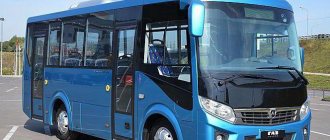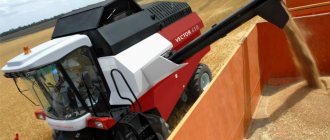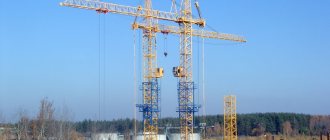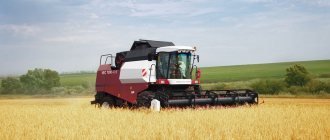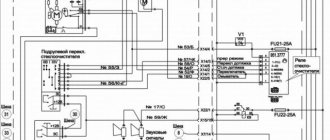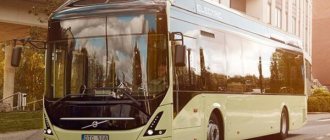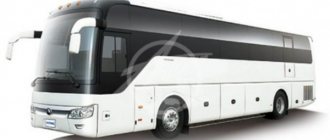Author: Oleg
24 August 2016 13:11
Tags: vector gases groove
18846
15
Following the new GAZON, GAZelle and Ural, united under the “NEXT” brand, a completely new Vector NEXT bus was revealed, which is assembled at the facilities of Nizhny Novgorod and the Pavlovsk Bus Plant.
0
Source:
See all photos in the gallery
Products from the city of Pavlovo have long become a common means of transport for city residents - the legendary “PAZIKS” are almost the most common type of public transport in the vast expanses of our homeland.
0
Source:
The easily recognizable profile of the bus can be seen both on city lines and on suburban routes. Put on the assembly line back in 1989, the hard worker PAZ-3205 is still in production with minor modifications.
×
The branded GAZ deer now appears on the false radiator grille of the new product.
0
Source:
The bus is equipped with a 4-cylinder, 150-horsepower YaMZ-53443 turbodiesel engine of Euro-5 standard. GAZon also received the transmission, suspension, chassis, and some interior elements.
0
Source:
And in 2022, an engine running on liquefied natural gas should appear in the lineup. The assembly of the new bus takes place according to a two-stage scheme: a self-propelled chassis equipped with a temporary seat for transportation comes off the assembly line in Nizhny Novgorod, and already 70 kilometers from GAZ the bus takes on its finished form.
0
Source:
The model range includes several variants of the Vector's interior, with a capacity of 17 to 25 seats. And the total “passport” capacity is up to 70 people. The length, depending on the capacity, will vary from 7 to 9 meters.
PAZ Vector Next owner reviews
- Konstantin, Ekaterinoslavl. A compact and maneuverable bus, the Vector-Next model is a worthy successor to the family of good old PAZ buses. The bus has a fairly short wheelbase, but it should be noted that it has a solid rear overhang. In general, the bus is good, but if all passengers sit in the back seats, there may be a slight advantage, although of course things won’t get worse. But it's still unpleasant. A 150-horsepower diesel engine consumes 25 liters per 100 km. It is economical and high-torque, you can’t hear it much in the cabin, but vibrations travel throughout the cabin. Of course, the level of comfort in the Vector-Next model is an order of magnitude higher than that of the good old 3205. A completely different level, and the passenger capacity is more than 20 seats. Together with those standing, it turns out to be about 50 people.
- Yaroslav, Penza. At work they finally gave me something new - PAZ Vector Next. Cool car, it is no worse than many modern foreign cars. Now you can be proud of the domestic auto industry, because this model is made from Russian parts, even the engine is from the Yaroslavl plant. The diesel engine with a power of 150 horses is endowed with good traction and acceleration dynamics; it is economical in the urban cycle, as well as on the highway. You can confidently drive at 100 km/h without fear of excessive fuel consumption, even with the interior loaded to capacity. By the way, it can accommodate about 50 passengers. In the city, the car consumes 20-25 liters, depending on driving style, number of stops and quality of roads.
- Gregory, Stavropol region. I have a 2016 PAZ Vector-Next, it was provided to me by a transport company for urban and suburban transportation. I liked the comfortable driver's seat, which can be configured at your discretion. The seat is moderately soft, the steering wheel can only be adjusted by tilt angle. I was pleased with the developers' attention to detail. For example, there are hooks behind the back of the driver's seat for hanging clothes. In addition, under the hangers there was a place for a small drawer in which you can put personal belongings, documents, etc. The glove compartment also pleased with its correct and voluminous shape. The engine is diesel, produced at the Yaroslavl plant, meets the Euro-5 eco-standard. It can be started with half a turn, even in cold weather. I also liked that the bus is already configured from the factory for constant operation, so you don’t need to configure or customize anything, except maybe the seat. The brakes are effective, there is enough traction, there is a power reserve. Average fuel consumption is around 25 liters, more is very rare. The seat upholstery is simple, but they have a high backrest, making passengers comfortable and cozy.
- Boris, Nizhny Novgorod region. I've been riding this bus for about a year. I ride with passengers on all kinds of roads, including rural paths. Unfortunately, this is where the shortcomings arise, and I compare this with the old model 3205. I would be interested to know from the developers how thoroughly this car was tested in rural and suburban areas? I say this because Vector-Next is poorly suited for such conditions. The car is thrown all over the road, you have to constantly steer. The suspension is energy-intensive, and the suspension travel is large, even too much - because of this, stability on uneven roads suffers. The bus bounces on roads with slush or even small potholes. At least, such discomfort occurs at speeds above 50 km/h. Fuel consumption per 100 km is 25 liters. The diesel engine is high-torque and economical, there are no complaints about it. All three buses that work for our transport company are working as hard as they can, so to speak. The suspension is working to the limit. I don't know how long it will last. Of course, the Vector-Next model must be compared with foreign cars. So I compared. And against the backdrop of the good old PAZ 3205, the car is certainly a creditable one, no doubt about it.
- Valery, Rostov region. PAZ Vector-Next is a powerful and dynamic bus for the city. The car belongs to the small class, can accommodate 25 passengers plus the same number of standing passengers. The interior is comfortable, spacious, in which case two hatches can be opened at once, air passes through effectively and cools the interior. In this case, you can not turn on the air conditioner, and this way the engine will consume less fuel. In the urban cycle, with economical driving, you can achieve 20 liters per hundred. The bus confidently navigates city traffic. Cool dynamics and effective brakes, I also liked the quality of the materials.
- Igor, Simferopol. We have only one such bus at our enterprise - we bought it in February 2022, the model has already traveled 35 thousand kilometers. The bus is still like new, it certainly looks awesome compared to the old PAZs. By the way, we still have them in service, since there is nothing to replace them with. These are cars from Ukrainian times. I hope they will get rid of them soon and replace them with more modern Vectors. My car is equipped with a 150-horsepower diesel engine and a manual 5-speed gearbox; in the city you can get a maximum of 25 liters - this is when loaded, with 50 passengers in the cabin. You can turn on the air conditioning, but then fuel consumption will increase. It’s good that the engine is not demanding on the quality of diesel fuel, unlike many modern imported engines, which are expensive to maintain.
Characteristic
What kind of car is this? "GAZ Vector Next" is a bus designed for suburban and urban transportation. It was first presented to the public in 2015 at the Moscow Crocus Expo exhibition.
Serial production started a year later. The machine is available in several modifications. So, there are versions for 7.1, 7.6 and 8.5 meters. What is noteworthy is that the model was developed at the Gorky Automobile Plant, but is produced at the Pavlovsk Automobile Plant. “GAZ Vector Next” is designed to replace the obsolete grooves of the 3205 model, which have been produced since the times of the USSR.
Dimensions
As for the dimensions, the width of the GAZ Vector Next bus is 2.45 meters, the height is 2.9 meters. But the length may be different. As we said earlier, there are modifications for 7.1, 7.6 and 8.5 meters.
The bus is highly maneuverable. Even with the longest body, it can maneuver through narrow streets. The wheelbase of the car is almost 4 meters. Naturally, there is no talk of any off-road conditions here. This is a purely city bus.
Model features
The development of machines from the Vector NEXT series was based on a modular design. Therefore, the Pavlovsk plant assembles models of various sizes, saving time and material resources on the creation and production organization of the entire model range. The main advantages of PAZ “Vector NEXT” buses include:
- increased maneuverability;
- rear air suspension;
- available spare parts;
- reliable operation of the suspension on different types of road surfaces;
- the most balanced resource of power units and body elements;
- disc brakes;
- built-in ZF steering gear.
Comfort option
Pavlovsk Bus Plant offers vehicles with different equipment. The “Comfort” option is optional, so it is usually not included in the standard equipment of PAZ buses. It includes:
- different seating options;
- tinted glazing;
- separate heating system for the driver's seat;
- electronic route indicators;
- luggage racks;
- air conditioning system;
- metallic painting of body parts;
- high ergonomics of the driver's seat.
"GAZ Vector Next": technical characteristics
An engine from the Yaroslavl Motor Plant is used as a power unit. As you know, gasoline engines are not made in Yaroslavl. Therefore, the GAZ Vector Next is equipped with a 4.4-liter in-line 4-cylinder diesel engine. The engine features a direct injection system and oil-cooled turbocharging. It also uses an exhaust gas recirculation system. Previously, it was equipped with GAZ trucks. In reviews, owners say that this system is not very reliable. The warning light on the instrument panel often lights up, and the engine starts to run erratically. The essence of this system is quite simple - all the dirt that goes into the manifold is returned back to the intake. Thus, excess soot is re-burned in the cylinders. This has a positive effect on the environmental friendliness of the exhaust, but is very harmful to the engine. In the reviews, the owners say that for normal operation, they have to “cut out” the software of this system and install plugs in the motor.
But let's continue about our Yaroslavl motor. The environmental exhaust standard is Euro 5 (thanks to the recirculation system). The maximum power of the Yaroslavl engine is 150 horsepower. Torque – 500 Nm at 1500 rpm. The engine has a simple cast iron block and has a long service life. However, due to the introduction of technological innovations, problems may occur with it. The YaMZ engine is paired with a C40R13 manual gearbox produced by the Gorky Automobile Plant. The transmission was previously installed on LAWNs, so it has long proven its reliability. There are no electronics in the transmission - all shifts are made mechanically. The average fuel consumption of the GAZ Vector Next bus is 20 liters per hundred kilometers. Acceleration to hundreds was not regulated by the manufacturer. But the maximum speed is exactly 100 kilometers per hour. In the future, the manufacturer plans to expand the range of power units to include engines running on gas engine fuel.
PAZ 320455-04 Vector Next
DESCRIPTION
PAZ 320455-04 Vektor NEXT 8.8 meters is a new extended model for 2022. "Vector Next" intercity is designed to work on long routes. The aggregate base and modern systems will ensure ease of control and good stability on various categories of roads. Soft ergonomic seats will make long trips comfortable for passengers. Luggage shelves and a compact luggage compartment will allow you to conveniently arrange things so that they do not interfere during travel, and the presence of belts on the passenger seats will ensure safety. The machine will cope well both with work on regular routes and with tourist trips.
Safety is ensured by the modern electronic traction control system ASR and the electronic brake force distribution (EBD) system.
As an option, it can be equipped with an ESC stability control system, which helps prevent the bus from skidding when turning.
“Vector Next” was twice awarded the prestigious “Best Bus of the Year” award. The Vector Next bus is distinguished by its affordable price, ease of maintenance and favorable cost of ownership, high service life of the body and power units, as well as high maneuverability. It has a modern exterior and interior design that corresponds to the advanced trends in the global bus industry. The new model uses the most modern materials and components.
CHARACTERISTICS
BODY LIFE 10 YEARS MAXIMUM SPEED 100 KM/H WHEELS FORMULA 4X2 NUMBER OF SEATS 48 SEATS 30 ECOLOGICAL STANDARD EURO 5
RELIABILITY
- High balanced life of the body and power units
- Suspension reliability on roads with any surface
- High maneuverability
- Availability of spare parts
- Disc brakes
- Rear air suspension
- Integrated ZF steering gear
PERFORMANCE INDICATORS
- Favorable cost of ownership
- Minimal maintenance costs
- Affordable price
COMFORT*
- Air conditioner
- Luggage racks
- Various seat options
- Tinted double glazed windows
- Metallic body paint
- Electronic route indicators
- Ergonomic driver's workplace
- Efficient separate heating system for the workplace
SAFETY*
- CCTV system with DVR
- Digital tachograph
- GLONASS/GPS
- Fire extinguishing system
*Is an optional extra and may not be included as standard.
DESIGN
- Modern interior and exterior design
- Spotlight lenses
- Curved front bumper improves aerodynamics
SPECIFICATIONS
Length/Width/Height, mm 8800/2445/2915 (3155 (with air conditioning))
Number/width of doors, mm 1/650, 1/650 (emergency)
Ceiling height in the cabin, mm 1950
BASIC FEATURES
Body type Semi-supporting, wagon layout
Min. turning radius, m 11
Curb/technically permissible weight, kg 7500/12500
Load on front/rear axle based on technically permissible weight, kg 3500/6550
Total number of seats (including landings) 48 (30)
Seats: Soft, separate, adjustable
Fuel tank/gas cylinder capacity, l 105
Chassis/axle C40R13, manufactured by GAZ
Steering mechanism Integral type with hydraulic booster
Brake system Brakes – disc with automatic clearance adjustment,
brake drive – pneumatic, with ABS, ASR
Ventilation Natural, through vents in the side windows and hatches in the roof
Heating system Independent autonomous liquid pre-heater and 3 cabin heaters
Tires 245/70 R19.5
UNIT CHARACTERISTICS
Engine Diesel engine YaMZ 534
Number and arrangement of cylinders 4R, vertical
Euro-5 environmental safety standards
Working volume, l 4.43
Engine power, kW (hp)/min 124.2 (168.9) at 2300 min-1
Max. torque, Nm/min 597 at 1200…1600 min-1
Engine location Front, longitudinal
Transmission: Fast Gear 5-speed manual transmission, 6-speed automatic transmission.
Maximum speed, km/h 100
Warranty for the bus is 3 years or 150 thousand km.
All technical specifications are for informational purposes, please check the exact details by calling the numbers listed in the “Contacts” section.
